Telangana
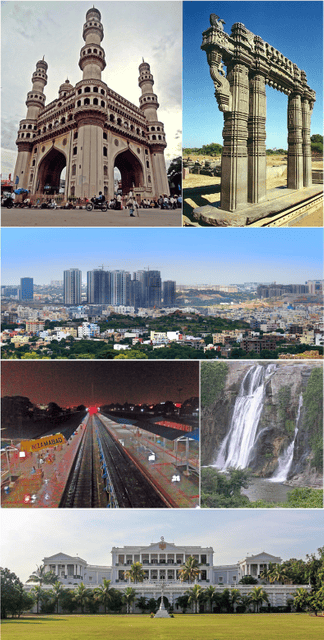
Telangana

Telangana | |
|---|---|
State | |
| Anthem: "Jaya Jaya He Telangana Janani Jayakethanam" | |
 Location of Telangana in India | |
| Coordinates (Telangana):17°21′58″N 78°28′30″E [116] | |
| Country | |
| Formation | 2 June 2014 |
| Capital and largest city | Hyderabad† |
| Districts | ****33 |
| Government | |
| • Body | Government of Telangana |
| • Governor | Tamilisai Soundararajan[1] |
| • Chief minister | K. Chandrashekar Rao (TRS) |
| • Legislature | Bicameral (119 + 43 seats) |
| • Parliamentary constituency | Rajya Sabha 7 Lok Sabha 17 |
| • High Court | High Court for the State of Telangana |
| Area | |
| • Total | 112,077 km2(43,273 sq mi) |
| Area rank | 11th |
| Population (2011)[2] | |
| • Total | 35,193,978 |
| • Rank | 12th |
| • Density | 307/km2(800/sq mi) |
| Demonym(s) | Telugu / Telanganite |
| GDP(2018–19) | |
| • Total | ₹8.66 lakh crore(US$130 billion) |
| • Per capita | ₹206,107(US$3,000) |
| Languages | |
| • Official | Telugu[5] |
| • Additional official | Urdu[5][6] |
| Time zone | UTC+05:30 (IST) |
| ISO 3166 code | IN-TG |
| Vehicle registration | TS- |
| HDI(2018) | |
| Literacy(2011) | 66.46% |
| Website | www.telangana.gov.in [117] |
| ^†Temporary Joint Capital with Andhra Pradesh not more than 10 years ††Common for Telangana and Andhra Pradesh | |
| Symbols of Telangana | |
| Emblem | Kakatiya Kala Thoranam, Charminar |
| Song | Jaya Jaya He Telangana Janani Jayakethanam[8] |
| Animal | Spotted deer[8] |
| Bird | Indian Roller[8] |
| Flower | Senna auriculata[8] |
| Fruit | Mango |
| Tree | Prosopis cineraria[8] |
| River | Godavari, Krishna River, Manjira River and Musi River |
| Sport | Kabaddi |
Telangana (/tɛlənˈɡɑːnə/ (listen)) is a state in India situated on the centre-south stretch of the Indian peninsula on the high Deccan Plateau. It is the eleventh largest state and the twelfth-most populated state in India with a geographical area of 112,077 km2 (43,273 sq mi) and 35,193,978 residents as per 2011 census.[9] On 2 June 2014, the area was separated from the northwestern part of Andhra Pradesh as the newly formed 29th state with Hyderabad as its historic permanent capital. Its other major cities include Warangal, Nizamabad and Karimnagar. Telangana is bordered by the states of Maharashtra to the north, Chhattisgarh to the east, Karnataka to the west, and Andhra Pradesh to the east and south.[10] The terrain of Telangana region consists mostly of hills, mountain ranges, and thick dense forests covering an area of 27,292 sq. km. As of 2019, the state of Telangana is divided into 33 districts.
Throughout antiquity and the Middle Ages, the region now known as Telangana was ruled by multiple major Indian powers such as the Cholas, Mauryans, Satavahanas, Chalukyas, Kakatiyas, Delhi Sultanate, Bahmani Sultanate, Golconda Sultanate. During the 16th and 17th centuries, the region was ruled by the Mughals.[11][12] The region is known for its Ganga-Jamuni Tehzeeb. During the 18th century and the British Raj, Telangana was ruled by the Nizam of Hyderabad.[13] In 1823, the Nizams lost control over Northern Circars (Coastal Andhra) and Ceded Districts (Rayalseema), which were handed over to the East India Company. The annexation by the British of the Northern Circars deprived Hyderabad State, the Nizam's dominion, of the considerable coastline it formerly had, to that of a landlocked princely state with territories in the central Deccan, bounded on all sides by British India. Thereafter, the Northern Circars were governed as part of Madras Presidency until India's independence in 1947, after which the presidency became India's Madras state.[14]
The Hyderabad state joined the Union of India in 1948 after an Indian military invasion. In 1956, the Hyderabad State was dissolved as part of the linguistic reorganisation of states and Telangana was merged with the Telugu-speaking Andhra State (part of the Madras Presidency during the British Raj) to form Andhra Pradesh. A peasant-driven movement began to advocate for separation from Andhra Pradesh starting in the early 1950s, and continued until Telangana was awarded separate statehood on 2 June 2014.[15]
The economy of Telangana is the eighth-largest state economy in India with ₹8.66 lakh crore (US$130 billion) in gross domestic product and a per capita GDP of ₹206,000 (US$3,000).[3][16] Telangana ranks sixteenth among Indian states in human development index.[7] The state has emerged as a major focus for robust IT software, industry and services sector. The state is also the main administrative centre of many Indian defence aero-space and research labs like Bharat Dynamics Limited, Defence Metallurgical Research Laboratory, Defence Research and Development Organisation and Defence Research and Development Laboratory.[17]
The cultural hearts of Telangana, Hyderabad, and Warangal, are noted for their wealth and renowned historical structures – Charminar, Qutb Shahi Tombs, Paigah Tombs, Falaknuma Palace, Chowmahalla Palace, Warangal Fort, Kakatiya Kala Thoranam, Thousand Pillar Temple and the Bhongir Fort in Yadadri Bhuvanagiri district. The historic city Golconda in Hyderabad established itself as a diamond trading center and, until the end of the 19th century, the Golconda market was the primary source of the finest and largest diamonds in the world. Thus, the legendary name Golconda Diamonds became synonymous with Golconda itself. The Golconda region has produced some of the world's most famous diamonds, including the colorless Koh-i-Noor (owned by the United Kingdom), the blue Hope (United States), the pink Daria-i-Noor (Iran), the white Regent (France), the Dresden Green (Germany), and the colorless Orlov (Russia), Nizam and Jacob (India), as well as the now lost diamonds Florentine Yellow, Akbar Shah and Great Mogul. Religious edifices like the Lakshmi Narasimha Temple in Yadadri Bhuvanagiri district, Makkah Masjid in Hyderabad, and Medak Cathedral are several of its most famous places of worship.
Telangana | |
|---|---|
State | |
| Anthem: "Jaya Jaya He Telangana Janani Jayakethanam" | |
 Location of Telangana in India | |
| Coordinates (Telangana):17°21′58″N 78°28′30″E [116] | |
| Country | |
| Formation | 2 June 2014 |
| Capital and largest city | Hyderabad† |
| Districts | ****33 |
| Government | |
| • Body | Government of Telangana |
| • Governor | Tamilisai Soundararajan[1] |
| • Chief minister | K. Chandrashekar Rao (TRS) |
| • Legislature | Bicameral (119 + 43 seats) |
| • Parliamentary constituency | Rajya Sabha 7 Lok Sabha 17 |
| • High Court | High Court for the State of Telangana |
| Area | |
| • Total | 112,077 km2(43,273 sq mi) |
| Area rank | 11th |
| Population (2011)[2] | |
| • Total | 35,193,978 |
| • Rank | 12th |
| • Density | 307/km2(800/sq mi) |
| Demonym(s) | Telugu / Telanganite |
| GDP(2018–19) | |
| • Total | ₹8.66 lakh crore(US$130 billion) |
| • Per capita | ₹206,107(US$3,000) |
| Languages | |
| • Official | Telugu[5] |
| • Additional official | Urdu[5][6] |
| Time zone | UTC+05:30 (IST) |
| ISO 3166 code | IN-TG |
| Vehicle registration | TS- |
| HDI(2018) | |
| Literacy(2011) | 66.46% |
| Website | www.telangana.gov.in [117] |
| ^†Temporary Joint Capital with Andhra Pradesh not more than 10 years ††Common for Telangana and Andhra Pradesh | |
| Symbols of Telangana | |
| Emblem | Kakatiya Kala Thoranam, Charminar |
| Song | Jaya Jaya He Telangana Janani Jayakethanam[8] |
| Animal | Spotted deer[8] |
| Bird | Indian Roller[8] |
| Flower | Senna auriculata[8] |
| Fruit | Mango |
| Tree | Prosopis cineraria[8] |
| River | Godavari, Krishna River, Manjira River and Musi River |
| Sport | Kabaddi |
Etymology
A popular etymology derives the word "Telangana" from Trilinga desa ("land of three lingas"), a region so called because three important Shaivite shrines were located here: Kaleshwaram, Srisailam and Draksharama.[18] According to Jayadhir Thirumala Rao, a former director of Andhra Pradesh Oriental Manuscripts Library and Research Centre, the name Telangana is of Gondi origin. Rao asserts that it is derived from "Telangadh", which according to him, means "south" in Gondi and has been referred to in "Gond script dating back to about 2000 years".[19]
One of the earliest uses of a word similar to Telangana can also be seen in a name of Malik Maqbul (14th century CE), who was called the Tilangani, which implies that he was from Telangana. He was the commander of the Warangal Fort (Kataka Pāludu).[20]
A 16th-century travel writer, Firishta, recorded in his book:
During the just reign of Ibrahim Kootb Shah, Tulingana, like Egypt, became the mart of the whole world. Merchants from Toorkistan, Arabia, and Persia resorted to it; and they met with such encouragement that they found in it inducements to return frequently. The greatest luxuries from foreign parts daily abounded at the king's hospitable board.[21]
The word "Telinga" changed over time to "Telangana" and the name "Telangana" was designated to distinguish the predominantly Telugu-speaking region of the erstwhile Hyderabad State from its predominantly Marathi-speaking one, Marathwada. After Asaf Jahis ceded the Seemandhra region to the British, the rest of the Telugu region retained the name Telingana and the other parts were called Madras Presidency's Circars and Ceded.[22]
History
Telangana was governed by many rulers, including the Maurya Empire (320 BCE–180 BCE), Satavahana dynasty (180 BCE–220 CE), Vakataka dynasty (250 CE–500 CE), Chalukya dynasty (543 CE–753 CE), Rashtrakuta dynasty (753 CE–982 CE), the Kakatiya Dynasty (1083 CE–1323 CE), the Musunuri Nayaks (1326 CE–1356 CE) the Delhi Sultanate, the Bahmani Sultanate (1347 CE–1512 CE), Vijayanagara Empire (1336 CE–1646 CE), Qutb Shahi dynasty (1512 CE–1687 CE), Mughal Empire (1687 CE–1724 CE) and Asaf Jahi Dynasty (1724 CE–1948 CE).
Early history
The Satavahana dynasty (230 BCE to 220 CE) became the dominant power in this region. It originated from the lands between the Godavari and Krishna rivers and was based at Amaravathi and Dharanikota.[23] After the decline of the Satavahanas, various dynasties, such as the Vakataka, Vishnukundina, Chalukya, Rashtrakuta and Western Chalukya, ruled the area.[24]
Kakatiya Dynasty
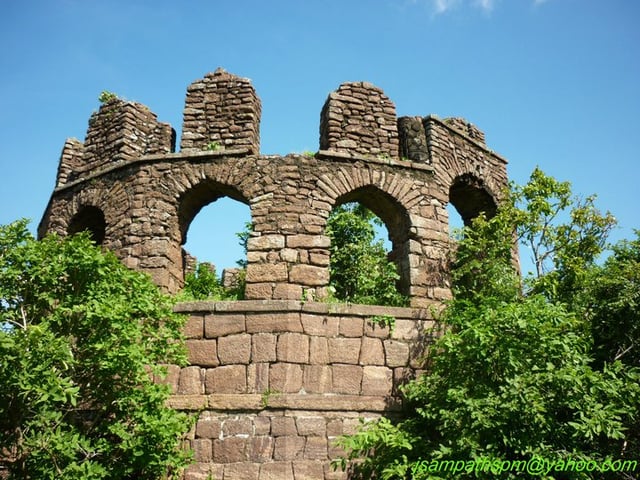
Ramagiri Fort ruins at Kalvacherla in Peddapalli district is an ancient fort initially built by the Sathavahanas and modified many times by other dynasties till the 16th century.
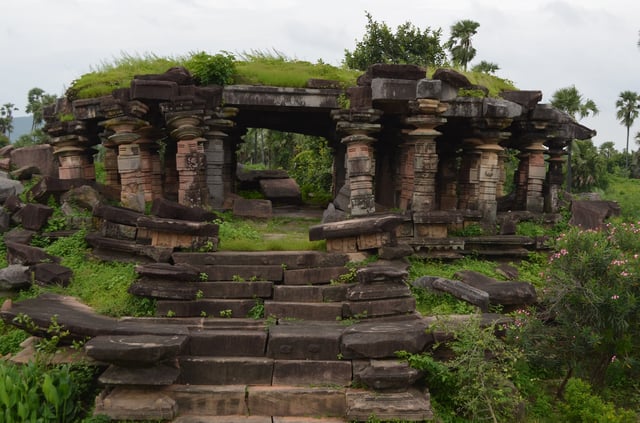
Kota Gullu, temple ruins built in the 12th century by Kakatiyas at Ghanpur, Mulug in Warangal district.
The Telangana area experienced its golden age during the reign of the Kakatiya dynasty, which ruled most parts of the present-day Andhra Pradesh and Telangana from 1083 to 1323 CE.[24] Rudrama Devi and Prataparudra II were prominent rulers from the Kakatiya dynasty. The dynasty weakened with the attack of Malik Kafur in 1309 and was dissolved after the defeat of Prataparudra by the forces of Muhammad bin Tughluq in 1323.[25][26]
Qutb Shahi and Asaf Jahi's
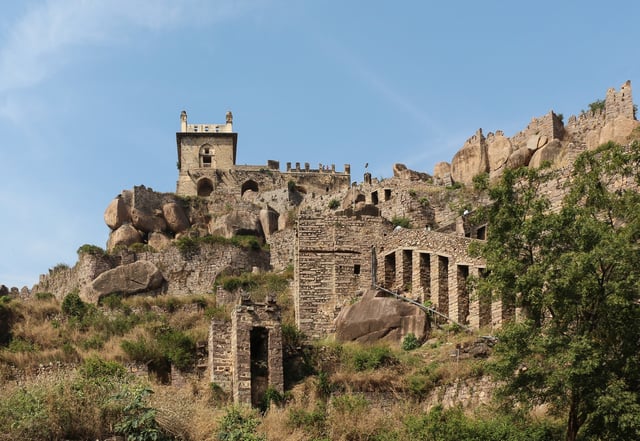
Golconda Fort
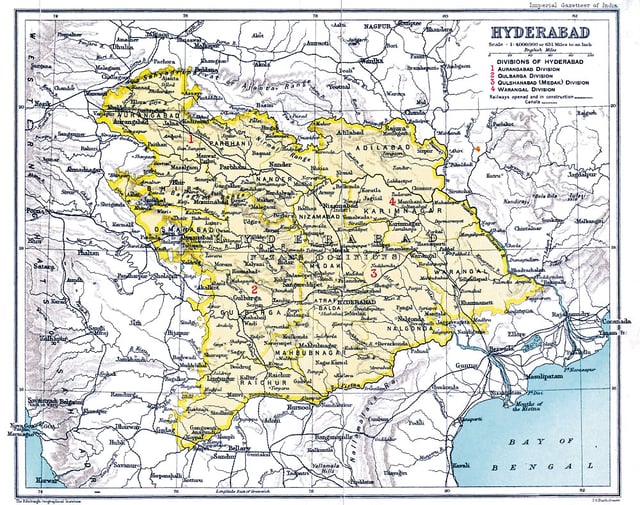
Hyderabad State in 1909.
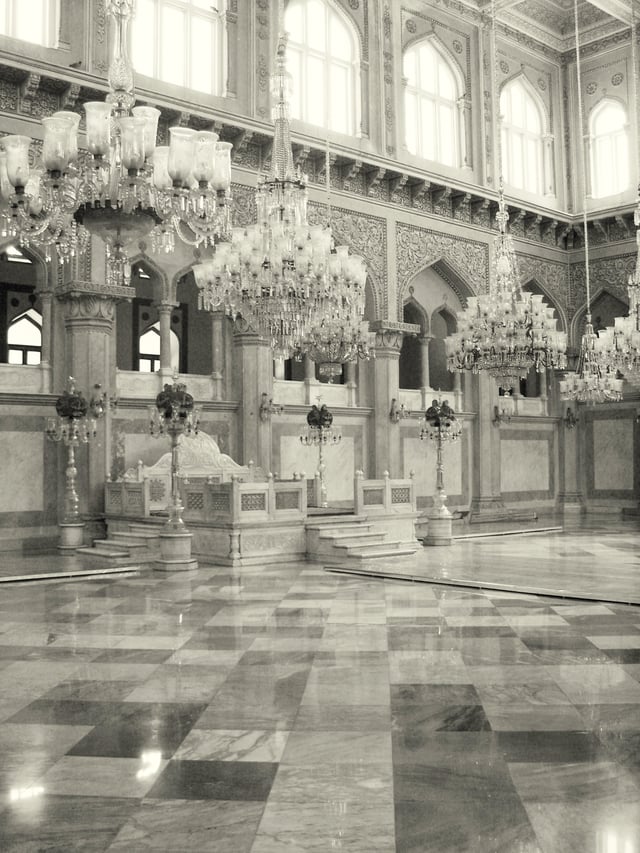
Telangana was the seat of numerous dynasties. The Chowmahalla Palace was home to the Nizams of Hyderabad.
The area came under the rule of the Delhi Sultanate in the 14th century, followed by the Bahmani Sultanate. Quli Qutb Mulk, a governor of Golconda, revolted against the Bahmani Sultanate and established the Qutb Shahi dynasty in 1518. On 21 September 1687, the Golconda Sultanate came under the rule of the Mughal emperor Aurangzeb after a year-long siege of the Golconda fort.[27]
In 1712, Qamar-ud-din Khan was appointed by emperor Farrukhsiyar as the viceroy of Deccan with the title Nizam-ul-Mulk (meaning "Administrator of the Realm"). He was later recalled to Delhi, with Mubariz Khan appointed as the viceroy. In 1724, Qamar-ud-din Khan defeated Mubariz Khan to reclaim the Deccan suba, establishing it as an autonomous province of the Mughal empire. He took the name Asif Jah, starting what came to be known as the Asif Jahi dynasty.[24] He named the area Hyderabad Deccan. Subsequent rulers retained the title Nizam ul-Mulk and were called Asif Jahi Nizams or nizams of Hyderabad. The Medak and Warangal divisions of Telangana were part of their realm.[28]
When Asif Jah I died in 1748, there was political unrest due to contention for the throne among his sons, who were aided by opportunistic neighbouring states and colonial foreign forces. In 1769, Hyderabad city became the formal capital of the Nizams. The Nizam Nasir-ud-dawlah, Asaf Jah IV signed the Subsidiary Alliance with the British in 1799 and lost its control over the state's defence and foreign affairs. Hyderabad State became a princely state among the presidencies and provinces of British India.[28]
Post-independence
When India became independent from the British Empire in 1947, the Nizam of Hyderabad did not want to merge with the Indian Union and wanted to remain independent. The Government of India annexed Hyderabad State on 17 September 1948 after a military operation called Operation Polo.[24] It appointed a civil servant, M. K. Vellodi, as first chief minister of Hyderabad State on 26 January 1950.[29] He administered the state with the help of English-educated bureaucrats from the Madras and Bombay states, who were familiar with British systems of administration unlike the bureaucrats of Hyderabad State who used a completely different administrative system. The official language of the state was switched from Urdu to English.
In 1952, Dr. Burgula Ramakrishna Rao was elected chief minister of the Hyderabad State in its first democratic election. During this time, there were violent agitations by some Telanganites to send the Madras state bureaucrats back and implement a rule by the natives (mulkis) of Hyderabad (Syed Alam Sharjil) was elected chief minister of Hyderabad after (Dr Burgula Ramakrishana Rao) for one year after he resigned from the post.[30]
Telangana Rebellion
The Telangana Rebellion was a peasant revolt supported by the communists. It originated in the Telangana regions of the Hyderabad State between 1946 and 1951, led by the Communist Party of India (CPI).[31]
The revolt began in the Nalgonda district against the feudal lords of Reddy and Velama castes. It quickly spread to the Warangal and Bidar districts. Peasant farmers and labourers revolted against the local feudal landlords (jagirdars and deshmukhs) and later against the Nizam Osman Ali Khan. The violent phase of the movement ended after the government of India's Operation Polo.[32] Starting in 1951, the CPI shifted to a more moderate strategy of seeking to bring communism to India within the framework of Indian democracy.[33]
States Reorganisation Commission
In December 1953, the States Reorganisation Commission (SRC) was appointed to form states on a linguistic basis.[34] An agreement was reached between Telangana leaders and Andhra leaders on 20 February 1956 to merge Telangana and Andhra with promises to safeguard Telangana's interests.[35] After reorganisation in 1956, the region of Telangana was merged with Andhra State to form Andhra Pradesh.
Following this Gentlemen's agreement, the central government established the unified state of Andhra Pradesh on 1 November 1956.[36][37][38] G.O 553 of 1959 from the united Andhra Pradesh state moved two revenue divisions of Bhadrachalam from East Godavari and Aswaraopeta from West Godavari to Khammam for administrative convenience.
Telangana movement
There have been several movements to revoke the merger of Telangana and Andhra, major ones occurring in 1969, 1972 and 2009. The movement for a new state of Telangana gained momentum in the 21st century by an initiative of Telangana Political Joint Action Committee, TJAC including political leadership representing Telangana area.[39] On 9 December 2009 the government of India announced the process of formation of the Telangana state. Violent protests led by people in the Coastal Andhra and Rayalseema regions occurred immediately after the announcement, and the decision was put on hold on 23 December 2009.
Formation of Telangana state in 2014
On 30 July 2013, the Congress Working Committee unanimously passed a resolution to recommend the formation of a separate Telangana state. After various stages the bill was placed in the Parliament of India in February 2014.[42] In February 2014, Andhra Pradesh Reorganisation Act, 2014 bill was passed by the Parliament of India for the formation of Telangana state comprising ten districts from north-western Andhra Pradesh.[43] The bill received the assent of the president and published in the Gazette on 1 March 2014.[44]
The state of Telangana was officially formed on 2 June 2014. Kalvakuntla Chandrashekar Rao was elected as the first chief minister of Telangana, following elections in which the Telangana Rashtra Samithi party secured majority.[45] Hyderabad will remain as the joint capital of both Telangana and Andhra Pradesh for a period, not more than ten years after that period Hyderabad shall be the capital of the state of Telangana and there shall be a new capital for the state of Andhra Pradesh.[46] Andhra Pradesh picked Amaravati as its capital and moved its secretariat in 2016 and legislature in March 2017 to its new capital.[47][48]
Geography

Telangana and its neighbours
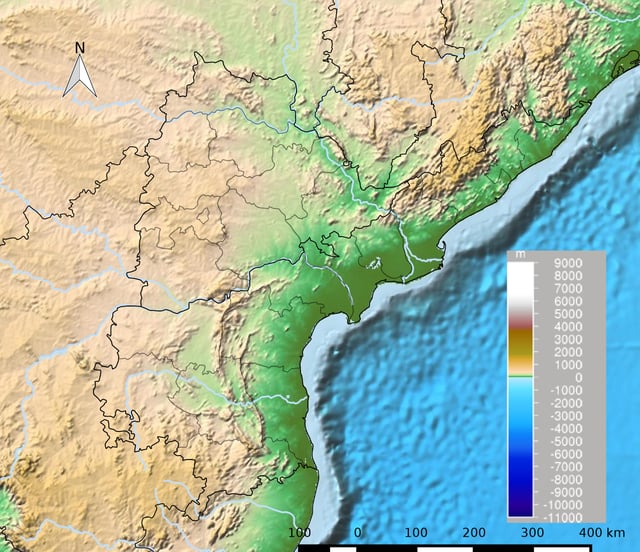
Andhra Pradesh and Telangana Topography
Telangana is situated on the Deccan Plateau, in the central stretch of the eastern seaboard of the Indian Peninsula. It covers 112,077 square kilometres (43,273 sq mi).[2] The region is drained by two major rivers, with about 79% of the Godavari River catchment area and about 69% of the Krishna River catchment area, but most of the land is arid.[10] Telangana is also drained by several minor rivers such as the Bhima, the Maner, the Manjira and the Musi.
The annual rainfall is between 900 and 1500 mm in northern Telangana and 700 to 900 mm in southern Telangana, from the southwest monsoons. Telangana contains various soil types, some of which are red sandy loams (Chalaka), Red loamy sands (Dubba), lateritic soils, salt affected soils, alluvial soils, shallow to medium black soils and very deep black cotton soils. These soil types allow the planting of a variety of fruits and vegetable crops such as mangoes, oranges, coconut, sugarcane, paddy, banana and flower crops.[49][50] [51]
Climate
Telangana is a semi-arid area and has a predominantly hot and dry climate. Summers start in March, and peak in May with average high temperatures in the 42 °C (108 °F) range. The monsoon arrives in June and lasts until September with about 755 mm (29.7 inches) of precipitation. A dry, mild winter starts in late November and lasts until early February with little humidity and average temperatures in the 22–23 °C (72–73 °F) range.
Ecology
The Central Deccan Plateau dry deciduous forests ecoregion covers much of the state, including Hyderabad. The characteristic vegetation is woodlands of Hardwickia binata and Albizia amara. Over 80% of the original forest cover has been cleared for agriculture, timber harvesting, or cattle grazing, but large blocks of forest can be found in Nagarjunsagar-Srisailam Tiger Reserve and elsewhere.[52] The more humid Eastern Highlands moist deciduous forests cover the Eastern Ghats in the eastern part of the state.
National parks and sanctuaries
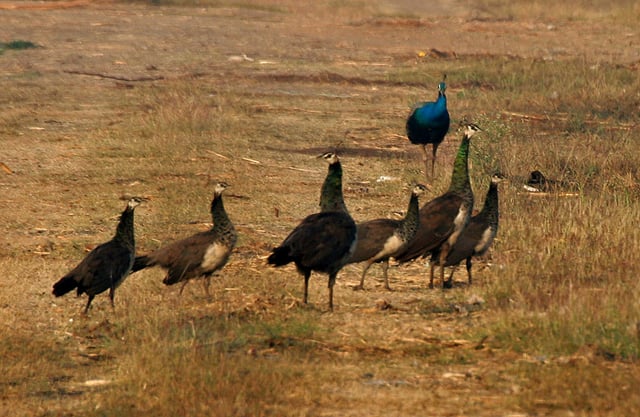
Indian peafowl (Pavo cristatus) near Hyderabad
Telangana has three National Parks: Kasu Brahmananda Reddy National Park in Hyderabad district, and Mahavir Harina Vanasthali National Park and Mrugavani National Park in Ranga Reddy district.
Wildlife Sanctuaries in Telangana include Eturunagaram Wildlife Sanctuary and Pakhal Wildlife Sanctuary in Warangal District, Kawal Tiger Reserve and Pranahita Wildlife Sanctuary in Adilabad district, Kinnerasani Wildlife Sanctuary in Khammam district, Manjira Wildlife Sanctuary in Medak district, Nagarjunsagar-Srisailam Tiger Reserve in Nalgonda and Mahbubnagar districts, Pocharam Wildlife Sanctuary in Medak and Nizamabad districts, Shivaram Wildlife Sanctuary in Karimnagar district.
Sacred groves are small areas of forest preserved by local people. Sacred groves provide sanctuary to the local flora and fauna. Some are included within other protected areas, like Kadalivanam in Nagarjunsagar–Srisailam Tiger Reserve, but most stand alone. There are 65 sacred groves Telangana—two in Adilabad district, thirteen in Hyderabad district, four in Karimnagar district, four in Khammam district, nine in Mahbubnagar district, four in Medak district, nine in Nalgonda district, ten in Ranga Reddy district, and three in Warangal district.[53]
Demographics
Telugu, one of the classical languages of India, is the official language of Telangana and Urdu is the second official language of the state.[55] About 77% of the population of Telangana speak Telugu, 12% speak Urdu, and 13% speak other languages.[56][57] Before 1948, Urdu was the official language of Hyderabad State, and due to a lack of Telugu-language educational institutions, Urdu was the language of the educated elite of Telangana.[58] After 1948, once Hyderabad State joined the new Republic of India, Telugu became the language of government, and as Telugu was introduced as the medium of instruction in schools and colleges, the use of Urdu among non Hyderabadi Muslims decreased.[59] Both Telugu and Urdu are used in services across the state, such as the Telangana Legislature website, with Telugu and Urdu versions of the website available,[60] as well as the Hyderabad metro, wherein both languages are used on station names and signs along with English and Hindi.[61] The Urdu spoken in Telangana is called Hyderabadi Urdu, which in itself is a dialect of the larger Dakhini Urdu dialects of South India. Although the language is orally spoken by most Hyderabadi Muslims, the language in a literary context has long been lost, and standard Urdu is used.[62]
According to the Backward Regions Grant Fund Programme 2009–10, there are 9 backward districts (all except Hyderabad) from Telangana and the rest are from other regions.[66]
Government and politics
Telangana is governed by a parliamentary system of representative democracy, a feature the state shares with other Indian states. Universal suffrage is granted to residents. There are three branches of government.
Executive authority is vested in the Council of Ministers headed by the Chief Minister, although the titular head of government is the Governor. The governor is the head of state appointed by the President of India. The leader of the party or coalition with a majority in the Legislative Assembly is appointed as the chief minister by the governor, and the Council of Ministers are appointed by the governor on the advice of the chief minister. The Council of Ministers reports to the Legislative Assembly.
The legislature, the Telangana Legislative Assembly and the Telangana Legislative Council, consists of elected members and special office bearers such as the Speaker and Deputy Speaker, that are elected by the members. Assembly meetings are presided over by the speaker or the deputy speaker in the speaker's absence. The Assembly is bicameral with 119 Members of the Legislative Assembly and 40 Member of the Legislative Council. Terms of office run for five years unless the Assembly is dissolved prior to the completion of the term. The Legislative Council is a permanent body with one-third members retiring every two years.
The judiciary is composed of the High Court of Judicature at Hyderabad and a system of lower courts.
Auxiliary authorities known as panchayats, for which local body elections are regularly held, govern local affairs. The state contributes seats to Lok Sabha.
The main players in the regional politics are the Telangana Rashtra Samithi, All India Forward Bloc, All India Majlis-e-Ittehadul Muslimeen, Telugu Desam Party, Bharatiya Janata Party and Indian National Congress. Following the Telangana Legislative Assembly Election in 2014, the Telangana Rashtra Samithi under Kalvakuntla Chandrashekar Rao was elected to power.
Administrative divisions
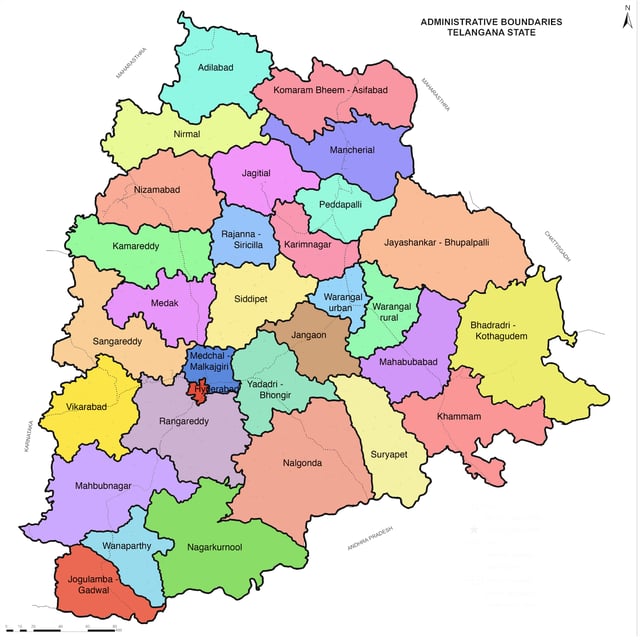
Telangana new districts created in 2016.
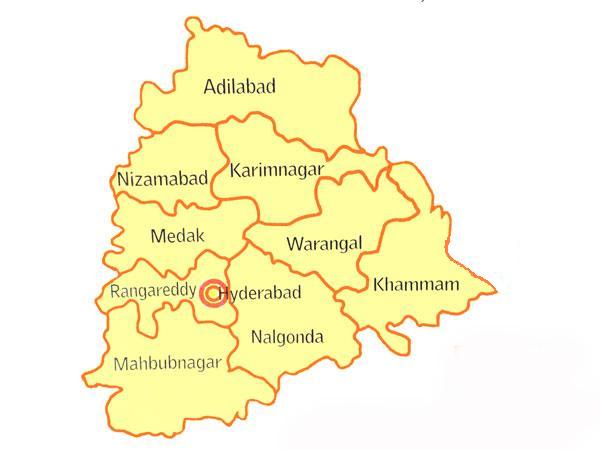
Telangana at the time of formation on 2 June 2014.
The districts in the state are:
| District | Headquarters | Earlier part of |
|---|---|---|
| Adilabad | Adilabad | Adilabad |
| Bhadradri Kothagudem | Kothagudem | Khammam |
| Hyderabad | Hyderabad | Hyderabad |
| Jagtial | Jagtial | Karimnagar |
| Jangaon | Jangaon | Warangal, Nalgonda |
| Jayashankar Bhupalpally | Bhupalpally | Warangal, Karimnagar |
| Jogulamba Gadwal | Gadwal | Mahabubnagar |
| Kamareddy | Kamareddy | Nizamabad |
| Karimnagar | Karimnagar | Karimnagar |
| Khammam | Khammam | Khammam |
| Komaram Bheem | Komaram Bheem | Adilabad |
| Mahabubabad | Mahabubabad | Warangal, Khammam |
| Mahbubnagar | Mahbubnagar | Mahbubnagar |
| Mancherial | Mancherial | Adilabad |
| Medak | Medak | Medak |
| Medchal–Malkajgiri | Shamirpet | Ranga Reddy |
| Mulugu | Mulugu | Warangal |
| Nagarkurnool | Nagarkurnool | Mahabubnagar |
| Nalgonda | Nalgonda | Nalgonda |
| Narayanpet | Narayanpet | Mahabubnagar |
| Nirmal | Nirmal | Adilabad |
| Nizamabad | Nizamabad | Nizamabad |
| Peddapalli | Peddapalli | Karimnagar |
| Rajanna Sircilla | Sircilla | Karimnagar |
| Ranga Reddy | Shamshabad | Ranga Reddy |
| Sangareddy | Sangareddy | Medak |
| Siddipet | Siddipet | Medak, Karimnagar, Warangal |
| Suryapet | Suryapet | Nalgonda |
| Vikarabad | Vikarabad | Ranga Reddy |
| Wanaparthy | Wanaparthy | Mahabubnagar |
| Warangal Rural | Geesugonda | Warangal |
| Warangal Urban | Warangal | Warangal |
| Yadadri Bhuvanagiri | Bhongir | Nalgonda |
There are a total of 12 cities in the state. Hyderabad is the biggest city in the state and 4th largest city in India. There are 13 municipal corporations and 132 municipalities in the state.
Economy
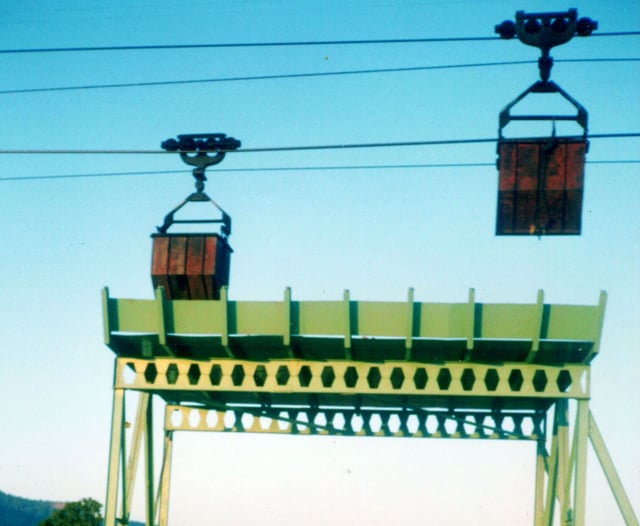
Coal Handling Ropeway near Aswapuram, Khammam district.
The economy of Telangana is mainly driven by agriculture. Two important rivers of India, the Godavari and Krishna, flow through the state, providing irrigation. Farmers in Telangana mainly depend on rain-fed water sources for irrigation. Rice is the major food crop. Other important crops are cotton, sugar cane, mango, and tobacco. Recently, crops used for vegetable oil production such as sunflower and peanuts have gained favour. There are many multi-state irrigation projects in development, including Godavari River Basin Irrigation Projects and Nagarjuna Sagar Dam, the world's highest masonry dam.[70][71]
The state has also started to focus on the fields of information technology and biotechnology. Telangana is one of top IT-exporting states of India. There are 68 Special Economic Zones in the state.[72]
Telangana is a mineral-rich state, with coal reserves at Singareni Collieries Company.[73]
Agriculture
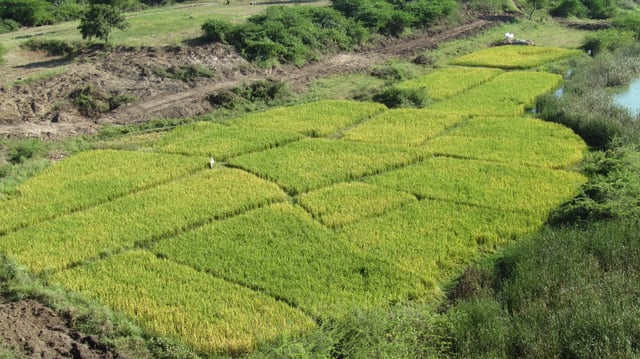
Paddy fields in Warangal district
Rice is the major food crop and staple food of the state. Other important crops are maize, tobacco, mango, cotton and sugar cane.[74] Agriculture has been the chief source of income for the state's economy. The Godavari and Krishna rivers flow through the state, providing irrigation. Apart from major rivers, there are small rivers like Tunga Bhadra, Bima, Dindi, Kinnerasani, Manjeera, Manair, Penganga, Pranahitha, peddavagu and Taliperu. There are many multi-state irrigation projects in development, including Godavari River Basin Irrigation Projects and Nagarjuna Sagar Dam, the world's highest masonry dam.[75]
Agri Export Zones for the following produce have been proposed for the following locations[76]:
Gherkins: Mahabubnagar, Rangareddy, Medak, Karimnagar, Warangal
Mangoes and grapes: Hyderabad, Rangareddy, Medak, Mahabubnagar
Industries

The HITEC City is a major IT hub of Hyderabad
In terms of services, Hyderabad is nicknamed "Cyberabad" due to the location of major software industries in the city.[78][79] Prior to secession, it contributed 10% to India's and 98% to Andhra Pradesh's exports in the IT and ITES sectors in 2013[80] With Hyderabad in the front line of Telangana's goal to promote information technology in India, the city boasts the HITEC City as its premier hub.
The state government is in the process of developing industrial parks at different places, for specific groups of industries. The existing parks are Software Park at Hyderabad, HITEC City for software units, Apparel Park at Gundlapochampalli, Export Promotion Park at Pashamylaram, Biotechnology park at Turkapally.
Hyderabad is also a major site for healthcare-related industries including hospitals and pharmaceutical organizations such as Nizam's Institute of Medical Sciences, Yashoda Hospitals, LV Prasad Eye Care, Akruti Institute of cosmetic and plastic surgery, Fever Hospital, Durgabai Deshmukh, Continental Hospitals and Apollo Hospitals. Many pharmaceutical and pharmaceutical-related companies like Dr. Reddy's Laboratories, Shantha Biotechnics and GVK BIO are based out of Hyderabad.
In addition, Hyderabad-based healthcare non-profits include the Indian Heart Association, a cardiovascular disease NGO.[81]
Tourism
Telangana State Tourism Development Corporation (TSTDC) is a state government agency which promotes tourism in Telangana.[82] Telangana has a variety of tourist attractions including historical places, monuments, forts, waterfalls, forests and temples.
Awards
Infrastructure
Power
Hydel and thermal power projects in the state meet the power requirements of the state. A number of new power projects are coming up in the State which is expected to generate additional power capacity in the state.
Irrigation Projects
| Project | River | District |
|---|---|---|
| Kaleswaram | Godavari | Jayashankar Bhupalpally |
| Sriram Sagar | Godavari | Nizamabad |
| Nagarjuna Sagar | Krishna | Nalgonda, Guntur |
| Srisailam | Krishna | Mahabubnagar, Kurnool |
| Nizam Sagar | Manjira | Nizamabad |
| Singur Dam | Manjira | Medak |
| Lower Manair Dam | Maner | Karimnagar |
| Mid Manair Dam | Maner | Rajanna Sircilla |
| Upper Manair Dam | Maner | Rajanna Sircilla |
| Sripada Yellampalli | Godavari | Peddapalli, Mancherial |
| Jurala | Krishna | Jogulamba Gadwal |
| Koil Sagar | Krishna | Mahabubnagar |
| Osman Sagar | Musi | Ranga Reddy district |
| Himayat Sagar | Musi | Ranga Reddy district |
Major Cities
Warangal
Nizamabad
Khammam
Karimnagar
Ramagundam
Mahbubnagar
Nalgonda
Adilabad
Suryapet
Siddipet
Miryalaguda
Jagtial
Major Towns
Mancherial
Sangareddy
Medak
Siricilla
Zaheerabad
Kamareddy
Kodad
Nirmal
Bodhan
Kothagudem
Gadwal
Mahabubabad
Nagarkurnool
Wanaparthy
Narayankhed
Huzurnagar
Armoor
Bellampalli
Bhadrachalam
Bhainsa
Bhongir
Jangaon
Korutla
Palwancha
Mandamarri
Naspur
Tandur
Vikarabad
Transport
The state is well connected with other states by means of road, rail and airways. The Telangana State Road Transport Corporation (TSRTC) is the major public transport corporation that connects all the cities and villages.[85] Mahatma Gandhi Bus Station (M.G.B.S) in Hyderabad is one of the largest bus stand in Asia.[86][87] Jubilee Bus Station in Secunderabad serves inter city bus services.
Roadways
The state has a total of 16 national highways and accounts for a total length of 2,690.23 km (1,671.63 mi).[88]
Railways
The history of railways in this region dates back to the time of Nizam of Hyderabad in 1874. The Nizam's Guaranteed State Railway, which had its beginnings in a line built privately by the HEH the Nizam. Much to the dismay of the British authorities, The Nizam bore all the expenses for the construction of the line.[89]
It operates under the auspices of the South Central Railway founded in 1966. The landmark building Rail Nilayam in Secunderabad is the Zonal Headquarter office of South Central Railway. Secunderabad and Hyderabad are the main divisions of South Central Railway that fall in the state.[90]
Airports
Rajiv Gandhi International Airport at Shamshabad is an international airport serving the city of Hyderabad It is the largest airport in the state and one of the busiest airports in the country. The government has plans to upgrade Warangal Airport, Nizamabad Airport[91] and Ramagundam Airport It also plans to construct airports in Ramagundam and Kothagudem.[92]
Warangal has a domestic airport in Mamunooru which was established in the year 1930 during Nizam period. All the exports and imports of Azam Jahi Mills, Warangal were done through the Warangal Airport.
Culture
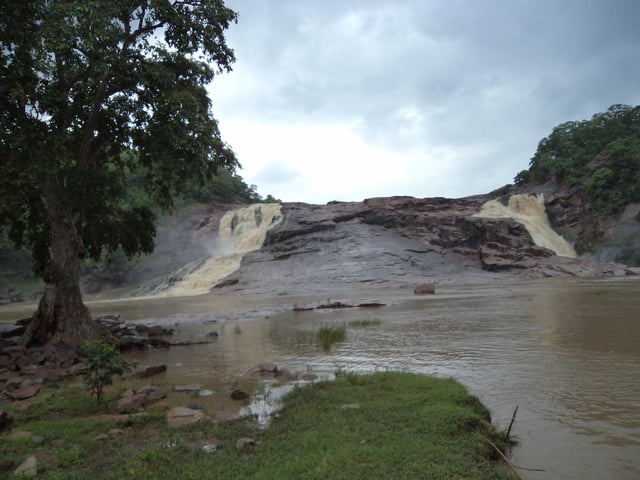
Kuntala Waterfalls in Adilabad
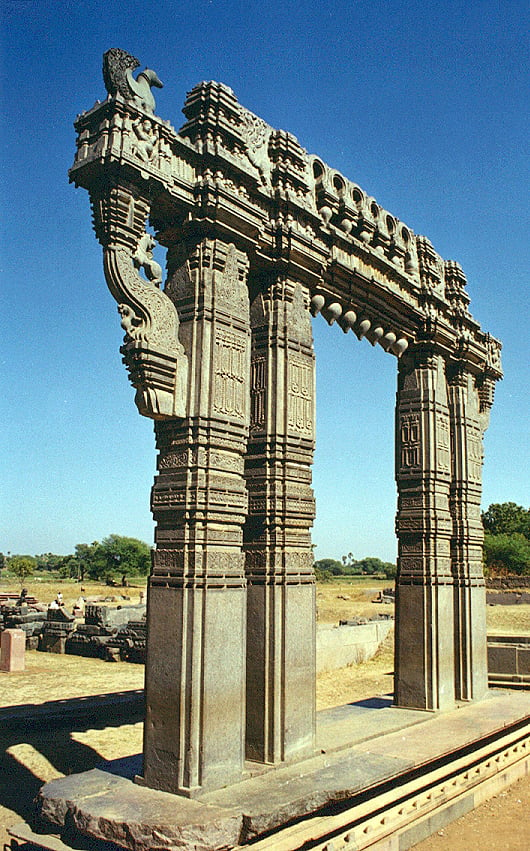
Kakatiya Kala Thoranam
Telangana culture combines cultural customs from Persian traditions, embedded during the rule of the region by the Mughals, Qutub Shahis and Nizams, with prominent and predominantly south Indian traditions and customs. The State has a rich tradition in classical music, painting and folk arts such as Burra Katha, shadow puppet show, and Perini Shivatandavam, Gusadi Dance, Kolatam.
Monuments
Charminar, Golconda Fort, Qutb Shahi Tombs, Chowmahalla Palace, Falaknuma Palace, Birla Mandir and Nagarjun sagar, Bhongir Fort, Warangal Fort, Khammam Fort are some of the monuments in and around Hyderabad.
Religious destinations
There are religious worship centers of different religions in the state.
Hindu worship destinations include Bhadrachalam Temple, Gnana Saraswati Temple, Yadagirigutta Temple, Ramappa Temple, Vemulawada Raja Rajeswara temple, the Thousand Pillar Temple.
The Muslim worship destinations such as Makkah Masjid near Charminar, Khairtabad Mosque, Koh-e-qaim, Mian Mishk Masjid, Toli Masjid and Spanish Mosque.
Christian worship centers include the Diocese of Dornakal of the Church of South India, Bahe Church of South India, and Medak Cathedral. There are also some Buddhist destinations, such as Nelakondapalli, Dhulikatta, Phanigiri and Kolanpaka.[93]
Telugu cinema
Telugu cinema, also known by its sobriquet as Tollywood, is a part of Indian cinema producing films in the Telugu language, and is centered in the Hyderabad, Telangana neighbourhood of Film Nagar.[94] In the early 1990s, the Telugu film industry had largely shifted from Chennai to Hyderabad. The Telugu film industry is the second-largest film industry in India next to Bollywood Film Industry and followed by Tamil film industry Kollywood)[95].[96] In the years 2005, 2006 and 2008 the Telugu film industry produced the largest number of films in India, exceeding the number of films produced in Bollywood.[97][98] The industry holds the Guinness World Record for the largest film production facility in the world.[99]
Waterfalls
Kuntala Waterfall (45 metres (148 ft)) located in Kuntala, Adilabad district.
Bogatha Waterfall is waterfall located in Koyaveerapuram G, Wazeedu Mandal, Jayashankar Bhupalpally district, Telangana. It is located 120 kilometres (75 mi) from Bhadrachalam, 140 kilometres (87 mi) away from Warangal and 329 kilometres (204 mi) from Hyderabad.
Savatula Gundam Waterfalls are one of the many waterfalls located in Adilabad district, Telangana, India. They are located 30 km (19 mi) from Komaram Bheem and 350 km (220 mi) from Hyderabad, the state capital.
Gowri Gundaala waterfalls at Sabitham village near Manthani in Peddapalli district.
Education
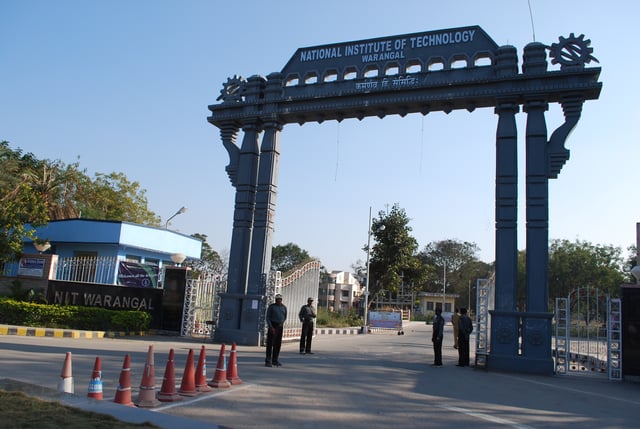
NIT Warangal main gate
Telangana has multiple institutes of higher education universities along with numerous primary and secondary schools. The state is home to a number of institutes, which impart higher education. The Department of Higher Education deals with matters relating to education at various levels in the state of Telangana.
The government has established Rajiv Gandhi University of Knowledge Technologies Basar (RGUKT Basar) in 2008 to cater to the educational needs of the gifted rural youth of Telangana.[100] The higher education includes many colleges, universities and research institutes providing professional education in the fields of arts, humanities, science, engineering, law, medicine, business, and veterinary sciences, with undergraduate and post-graduation. The Indian Institute of Technology Hyderabad (IIT Hyderabad or IITH), a public engineering and research institution is situated in Sangareddy district in Telangana.
Sports
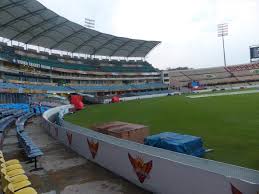
Rajiv Gandhi International Cricket Stadium
The Hyderabad cricket team is represented in the Ranji Trophy and has won twice. The SunRisers Hyderabad, an Indian Premier League franchise, is based in Hyderabad and has won the trophy once. Deccan Chargers, a currently defunct franchise from Hyderabad, also won the Indian Premier League once. The Rajiv Gandhi International Cricket Stadium is the home ground of both Hyderabad cricket team and Sunrisers Hyderabad. It hosts international as well as domestic matches. The Hyderabad Hunters, a Premier Badminton League franchise; the Telugu Titans, a Pro Kabaddi League franchise; the Hyderabad Sky, a UBA Pro Basketball League franchise and the Telugu Tigers, a Premier Futsal franchise are also based in Hyderabad. Hyderabad Hunters are previous winners of the Premier Badminton League title.
Notable sports persons from the state are Mohammad Azharuddin, V. V. S. Laxman, Mithali Raj, Pragyan Ojha, Saina Nehwal, P.V. Sindhu, Jwala Gutta, Parupalli Kashyap, Gagan Narang, Mukesh Kumar and Pullela Gopichand (Andhra Pradesh), as well as Sania Mirza who has been appointed as the "brand ambassador" of Telangana.
Other stadiums include G. M. C. Balayogi Athletic Stadium, Lal Bahadur Shastri Stadium and Gachibowli Indoor Stadium.
See also
Ganga-Jamuni tehzeeb
Index of Telangana-related articles
List of state highways in Telangana
List of Telangana people
Telangana Language Day
Temples of Telangana
